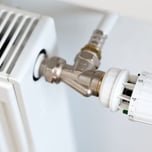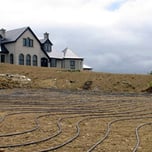Answer these simple questions and we will find you the BEST prices
Which type of solar quotes do you need?
It only takes 30 seconds
100% free with no obligation

Get up to 4 quotes by filling in only 1 quick form

Install a heat pump for less with the BUS grant

We’ve helped over 500,000 homeowners reduce their carbon footprint
- GreenMatch
- Ground Source Heat Pumps
- Ground Source Heat Pump Installation
6 Step-Guide to Ground Source Heat Pump Installation (2025)

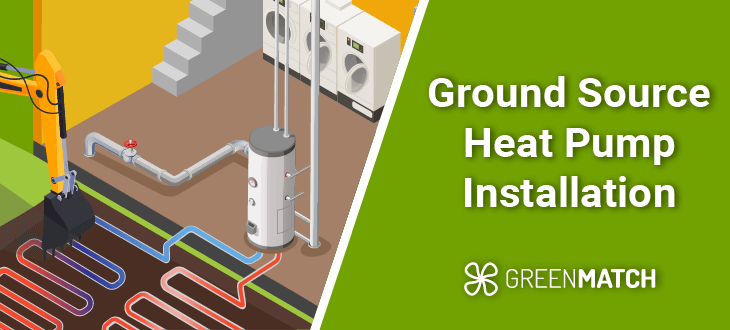
- Ground source heat pump installation costs typically range between £10,500 to £37,000, with horizontal systems ranging from £10,500 to £28,000 and vertical systems from £16,000 to £37,000, depending on installation type and system size.
- On average, ground source heat pumps can pay for themselves within a few years, thanks to annual savings of up to £2,000 and grants such as the UK government’s Boiler Upgrade Scheme (BUS).
- Renewable energy usage, low running costs, minimal maintenance, quiet operation, and discreet design are among the main benefits of ground source heat pumps.
Ground source heat pumps (GSHPs) are a type of renewable heating and cooling system that can extract heat from the ground to heat a building or even meet its hot water demands. This is done thanks to the ground's constant temperature, which provides heat all year long without the need to burn fossil fuels. GSHPs are an excellent energy-efficient, cost-effective, and sustainable heating option for your home.
In this article, we'll explain everything you need to know about GSHP installation, including the costs, steps involved, and different heat pump grants available in the UK. We'll also help you decide if they’re the best option for you.
Potential extras and installation costs, which vary by the installer, will affect the cost of ground source heat pumps. That’s why it’s best to compare several installers in your area. Instead of spending days on research and comparisons on your own, why not fill out our 30-second form and let us do the rest? We’ll find you up to 4 free quotes from trusted installers in your area. Click below to get started!
- Quotes from local engineers
- Payment by finance available
- Save £7,500 with BUS grant
It only takes 30 seconds



Is a ground source heat pump suitable for your home?
If you are a homeowner currently considering a ground source heat pump installation, there are a number of factors to consider. These initial considerations can go a long way towards ensuring your ground source heat pump installation process goes as smoothly and efficiently as possible:
- Do you have enough space in your backyard/garden for a horizontal array? Or would you need a borehole installation?
- Is your home currently well-insulated? If your home has a higher heat demand, you will likely require a larger system, which is more expensive to purchase, install, and run. It is recommended that if you are considering having a ground source heat pump installed, you first insulate your home to the highest possible degree.
The video below explains how a ground source heat pump works:

Ground source heat pump installation costs
Ground source heat pump installation costs typically range between £10,500 to £37,000, depending on the type of installation, the size of the system, and the household. Given that the performance of ground source heat pumps is such that, if properly designed and implemented, they can represent an extremely efficient and cost-saving form of heating for UK households, hiring a qualified and well-experienced contractor is imperative.
It’s worth mentioning that prospective homeowners should try not to be immediately put off by the upfront capital cost of a ground source heat pump installation. As with all things that produce long-term cost savings, GSHPs require a relatively substantial upfront investment.
The overall ground source heat pump cost in the UK will predominantly depend on whether you opt for a horizontal ground loop or a vertical borehole system. Vertical systems are considerably more expensive because of the ground source heat pump borehole cost. You will have to make this decision based on your ground conditions and the space you have available.
Generally speaking, a well-insulated home will need a smaller ground source heat pump installation with small ground loops, which will be less expensive than a ground source heat pump installation in a lesser-insulated home.
There is a significant difference in groundwork costs between horizontal and vertical ground loop systems, as can be seen below:
| Scenario | 1-2 Beds (3-6 kW) | 3-4 Beds (8-12 kW) | 5-6 Beds (16 kW) |
|---|---|---|---|
| Complex retrofit | £14,000 | £20,500 | £28,000 |
| New build | £13,500 | £20,000 | £27,000 |
| Simple retrofit | £10,500 | £16,000 | £23,000 |
| Scenario | 1-2 Beds (3-6 kW) | 3-4 Beds (8-12 kW) | 5-6 Beds (16 kW) |
|---|---|---|---|
| Complex retrofit | £16,000 | £27,000 | £37,000 |
These cost figures do not represent actual offers and are merely for general reference purposes. The exact costs will depend on your individual case requirements. Your best bet would be to consult with and gather quotes from a number of different heat pump brands so that you can become better acquainted with not only the costs associated with a ground source heat pump installation project but also the requirements of running and installing one.
Interested in getting a ground source heat pump? We can help you get free quotes from installers near you. Don’t waste hours searching on your own. Simply fill in our 30-second form, and we’ll do the rest. Receive up to 4 free quotes.
- Quotes from local engineers
- Payment by finance available
- Save £7,500 with BUS grant
It only takes 30 seconds



6-step guide to ground source heat pump installation

The fact that ground source heat pumps work by extracting solar energy stored in the ground means they can be installed virtually anywhere. The typical ground source heat pump system is generally made up of four basic components – the ground loop (which collects heat from the ground), the heat pump (which raises the heat to an appropriate temperature and transfers the resulting heat to the home), the heat distribution system, and the hot water heater.
Ground source heat pumps can have either open loop or closed loop systems buried underground. While the open loop system requires access to ponds or some body of water, closed loop systems do not. The following breakdown should help with understanding the differences.
| Characteristics | Open loop system | Closed vertical loop system | Closed horizontal loop system |
|---|---|---|---|
| How it works | Water is extracted from the ground and returned to an aquifer | Underground vertical pipes circulate heat exchange fluid in boreholes | Underground horizontal pipes laid in trenches circulate heat exchange fluid |
| Drawback | Output depends on the amount of water that can be extracted | Special equipment is needed for drilling the boreholes, which also makes it more expensive | Large area of land needed - much larger than vertical systems |
| Energy efficiency | More efficient than closed loop systems | Less efficient than open loop systems (therefore more boreholes required) | Less efficient than open loop systems |
| Cost efficiency | More efficient than closed loop systems | Less cost-efficient than open loop systems | Less cost-efficient than open loop systems |
Ground source heat pumps are one of the most cost-efficient renewable energy systems, and their installation process is not extremely difficult, either. However, some obstacles can make or break your energy efficiency ambitions with a ground source heat pump installation.
Therefore, the following steps explain ground source heat pump installation:
1. Assess your home
Perhaps the most important first step in the design of a ground source heat pump is adequate planning and preparation.
Have an installer visit your home and appraise exactly what type of heat pump, energy supply source, and energy distribution would be the best fit. The installer will also evaluate your domestic hot water requirements, existing exchanger and heating systems, the current level of insulation in the home, as well as the geology and hydrology of the soil in your land.
Only after gathering all this information would your installer be able to draw up a building heat load analysis and plan a well-designed ground source heat pump system for your home.
2. Excavate loop fields
Thereafter, your contractors will perform the excavation of horizontal or vertical loop fields so that later on pipes can be buried in the soil. The excavation process takes about one to two days, on average.
A key consideration in installing a ground source heat pump is the location and design of the loop. Horizontal loop systems are generally the most cost-efficient and involve the excavation of shallow trenches in which polyethylene pipes can be laid at depths of between 1m to 2m. Although horizontal installations are cheaper, they do require a minimum of ½ an acre of land.
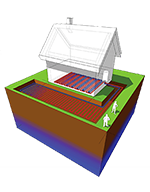
In cases where space is limited, an alternative to horizontal loop systems are vertical loop systems. Here, boreholes are dug using drilling rigs to depths of anywhere between 15m and 122m where pipes are then buried into them. These systems tend to be a little pricier to implement, but since ground temperatures are more stable the deeper the loop is located, the heat collection efficiency is also considerably higher.
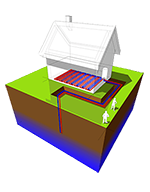
3. Install the pipes
The contractor will then install the pipes in the buried loop fields, which will later be filled with a mixture of water and antifreeze solution that will act as a heat exchanger.
4. Modify the heat distribution infrastructure
Then, your contractor will modify the ductwork and, if necessary, replace your old heat distribution infrastructure with a newer one. Ideally, this will be underfloor heating as this usually works best in conjunction with ground source heat pumps. For a one-man team, this can take up to three to four days to complete.
5. Install the heat pump
Lastly, your installer will connect the heat pump to the ductwork, the ground loop, and possibly the new in-floor heating system. Before turning on the heat pump for the first time, it is important to observe the following: water flow from the ground exchange loop, air temperatures, and amp draw on the heat pump.
6. Maintain the heat pump in good condition
The good news is that because ground source heat pumps have very few moving parts, usually very little can go wrong. Having said that, it is your responsibility to make sure that the heat pump is in good condition for as long as possible. Remember to perform seasonal adjustments to ensure that your heat pump operates as efficiently as possible during both heating and cooling periods.
Measuring the performance of ground source heat pumps
The heat output (kW) in relation to the electrical input (kW) is known as the "coefficient of performance" (CoP). Typically, a ground source heat pump has a CoP of 4, which, in broad terms, means that for every 1kW of electricity used to drive the heat pump, 4kW of heat is produced for space heating and domestic hot water.
For instance, a 200m² house that uses 11,000 kWh of energy for heating purposes and another 4,000 kWh for domestic hot water will need (11,000 + 4,000) / 4 = 3,750 kWh of electricity to run a ground source heat pump with a CoP of 4.
Ground source heat pump grants
As with owners of biomass boilers, air source heat pumps, and other renewable energy technologies, those considering ground source heat pumps can apply for various heat pump grants available as of 2025.
Grants such as the Boiler Upgrade Scheme (BUS) were launched to encourage homeowners to transition to renewable energy technologies, offering up to £7,500 in support for those opting for ground source heat pumps to lower heat pump costs in the UK.
To help you better understand all of the ground source heat pump grants available in the UK, we’ve compiled the table below to give you an overview of which grants are available, the eligibility requirements and how much you can expect to receive.
| Grant | Maximum funding | Eligibility criteria |
|---|---|---|
| Boiler Upgrade Scheme (BUS) | £7,500 | Grant eligibility requires property owners to own the property, have a valid EPC, and replace existing fossil fuel heating systems (oil, gas, electric, or LPG). |
| Home Energy Scotland Scheme | £15,000 | Scottish homeowners can access an interest-free loan of up to £15,000 for installing renewable energy systems. |
| ECO4 | Varies | The scheme supports low-income households with a property EPC rating of G, F, or E. |
Another measure to support homeowners in their transition to renewable sources of energy is the 0% VAT scheme. Your installer automatically applies this scheme, which means you won’t have to pay as much for energy-saving measures.
Furthermore, as heat pump grants are subject to change, it is highly advisable to keep an eye out for new developments. For this reason, contacting a specialist in the field can save you both time and money.
Choosing the right installer for your home
As mentioned earlier, a lot of factors must be taken into consideration before arriving at the overall design of a ground source heat pump installation project and its subsequent total cost calculation. In light of this, choosing the right (i.e. well-experienced as well as qualified) ground source heat pump installer is crucial. Although this can sometimes seem like quite a daunting task, it does not have to be. Your initial concerns should surround the following:
- How trustworthy, qualified, and experienced your ground source heat pump contractor is. (A good indicator of a trustworthy installer is if they offer to check your soil conditions prior to recommending a vertical or horizontal array.)
- Whether or not they are MCS-certified and a member of Renewable Energy Assurance Ltd (REAL).
- What warranties does your ground source heat pump installation come with, and for how long?
- Whether or not your chosen contractor is willing to offer a maintenance contract with performance guarantees to maintain the system.

In conclusion, the question becomes not so much about how to install a ground source heat pump, but rather which installer to work with. The main quality assurance authority for ground source heat pump installations in the UK is the Microgeneration Certification Scheme (MCS), so it is important that your installer is MCS-approved. Additionally, be sure to consult with or ask for references from owners of systems that are several years old.
Trying to find local installers on your own can take hours of unwanted hassle. Luckily, we can connect you with up to 4 local installers for free! Just fill in our 30-second form, and we’ll do the rest.
- Quotes from local engineers
- Payment by finance available
- Save £7,500 with BUS grant
It only takes 30 seconds




Alejandro is a copywriter at GreenMatch and is passionate about European environmental policy and renewable energy. He has conducted research on the European Green Deal’s impact on EU energy policy and climate adaptation, and he is committed to using his writing skills to promote sustainable policies.
We strive to connect our customers with the right product and supplier. Would you like to be part of GreenMatch?


